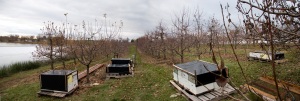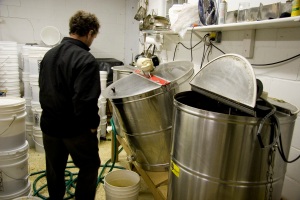by James Kleiner with edits by Megan Hines, Emily Larson and Sarah Milnar
 With a constantly changing menu, the kitchen of Common Roots Café is challenged to shape the menu around the seasonally fresh and available ingredients that are almost 90 percent locally grown (within 250 miles), organic or fair trade. Brian Frederickson, a Minnesota beekeeper, provides honey to Common Roots Café. He holds similar food ethics as Danny Schwartzman, owner of the restaurant, who tracks of the exact sources of the products he uses. In this case, Brian tracks what produces the fine variety of flavors in the honey. Brian bought a small apple orchard from David Bedford, professor at the University of Minnesota and inventor of the Honeycrisp Apple, but he soon found that he couldn’t make a living off it. He took interest in some beehives on the property, and noticed the naturally changing flavors of the honey and the unique flavors from particular plants in bloom during various parts of the season. Brian explained this initial process of discovery as one of chance. “I noticed by accident that the honey tastes different in the spring, summer and fall,” he said. “I came up with my own definition of single source honey: A notion that you have a hive of bees somewhere doing their own thing, and when they produce honey, it’s like a snapshot of some time, some part of some season, somewhere.”
With a constantly changing menu, the kitchen of Common Roots Café is challenged to shape the menu around the seasonally fresh and available ingredients that are almost 90 percent locally grown (within 250 miles), organic or fair trade. Brian Frederickson, a Minnesota beekeeper, provides honey to Common Roots Café. He holds similar food ethics as Danny Schwartzman, owner of the restaurant, who tracks of the exact sources of the products he uses. In this case, Brian tracks what produces the fine variety of flavors in the honey. Brian bought a small apple orchard from David Bedford, professor at the University of Minnesota and inventor of the Honeycrisp Apple, but he soon found that he couldn’t make a living off it. He took interest in some beehives on the property, and noticed the naturally changing flavors of the honey and the unique flavors from particular plants in bloom during various parts of the season. Brian explained this initial process of discovery as one of chance. “I noticed by accident that the honey tastes different in the spring, summer and fall,” he said. “I came up with my own definition of single source honey: A notion that you have a hive of bees somewhere doing their own thing, and when they produce honey, it’s like a snapshot of some time, some part of some season, somewhere.”
His philosophy developed into Ames Farm Single Source Honey, which places 300 beehives in 17 decentralized locations around southwestern Minnesota. With this method, he collects hundreds of flavors of raw honey throughout the seasons, creating unique blends that have no uniform color, flavor, texture or smell. During each season, basswood, sweet clover, goldenrod, Dutch clover and thistle are the primary plants that allow bees to create large amounts of honey. On his web site, Brian says all single source raw honey is unfiltered honey. “This means it was not exposed to heat outside of the beehive and is not heavily processed or blended. Raw honey contains beneficial vitamins, enzymes and yeasts which processed honey does not. It is very delicate and can be damaged by careless management of the beehives, the placement of the hives, and the removal of the honey from the hives. The aroma, flavor and body of the honey are all very much affected by all of these variables that are under the control of the beekeeper.”
 Brian’s jars are labeled with the hive number and location, enabling customers to search a database on the Ames Farm Web site to find the exact location that their honey was collected, the time period of production and its flavor profile. Before our interview in his small cottage office, I read local newspaper articles and perused the Ames Farm Single Source Honey Web site. I mentioned to Brian a few of the articles I had read that described him as a man who left a desk job to pursue a free lifestyle and be his own boss in a farm-related business. Dara Moskowitz, a writer for City Pages, explained that Brian shifted his life “so that he could raise apples, run with his sled dogs, and, generally, soak in as much sky and wind as his time on earth would allow.” This description made him laugh as he leaned back in his chair.
Brian’s jars are labeled with the hive number and location, enabling customers to search a database on the Ames Farm Web site to find the exact location that their honey was collected, the time period of production and its flavor profile. Before our interview in his small cottage office, I read local newspaper articles and perused the Ames Farm Single Source Honey Web site. I mentioned to Brian a few of the articles I had read that described him as a man who left a desk job to pursue a free lifestyle and be his own boss in a farm-related business. Dara Moskowitz, a writer for City Pages, explained that Brian shifted his life “so that he could raise apples, run with his sled dogs, and, generally, soak in as much sky and wind as his time on earth would allow.” This description made him laugh as he leaned back in his chair.
We discussed his philosophy of bee keeping. His process is unheard of in the commercial production industry. Conventionally, hives are shipped across the country to “chase the bloom” on the backs of trucks, traveling up to 5,000 miles per year. Then honey from the hives is thrown into a single melting pot and cooked to intentionally give it a more uniform taste, texture and color. The uniform product is then given a generic label, such as “clover” honey. But Brian said industrial beekeepers lose huge quantities of bees because of the amount stress the bees suffer. This often results in colony collapse disorder, a situation that arises when worker bees abandon a bee colony. Brian explained that one of the big problems is that bees are being “asked to pollinate almonds in February. That’s winter!” he said. “Then it’s on to blueberries, pumpkins, etcetera. It’s a mono-crop diet.” A single kind of nectar for several weeks at a time is not what a bee would live off of in nature.
Brian believes that he is one of the first people in the country to coin the term “feedlot beekeeping.” Brain said commercially raised bees consume “high density food, like in a feedlot, an unnatural nutritional source, all for some purpose of creating an industrial agricultural system.” This asks a lot of an organism that wasn’t even native to this part of the world to begin with. Although the conventional honey  process is necessary to sustain the current product demands, the system should be questioned by communities that experience the negative effects in the production of commodity crops.
process is necessary to sustain the current product demands, the system should be questioned by communities that experience the negative effects in the production of commodity crops.
The production of honey seems to be a rewarding lifestyle. In the time I spent observing and documenting areas of Brian’s land, it appears that planting new flowers and trees to assist in honey production provides additional environmental services to the land. Looking into the future, there will be an amount of question as to how long Ames Farm will sustain, and it will depend on the economy and how local communities respond to purchasing Brian’s product at the farmers markets and co-ops around Minneapolis. He produces more than 15,000 pounds of honey per year, which is not quite enough to make shipping costs extravagant, but the recent fluctuation of gas prices have been of concern. Rural land south of the Twin Cities is one option if Brian decides to expand somewhere with lower land taxes. And like Common Roots Café, having an urban location means one can attract an energetic response from the community.
To view these photos and more, please see the Ames Farm slideshow.





